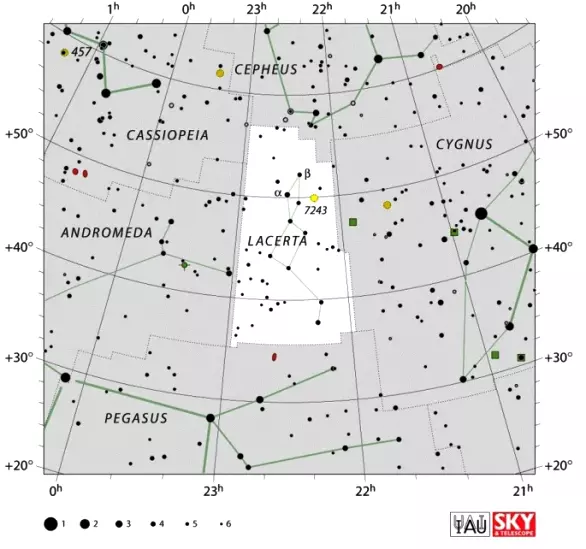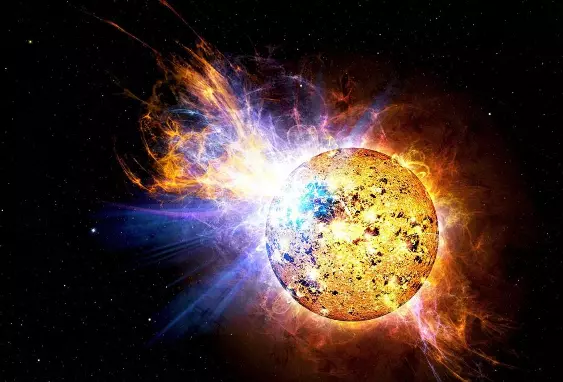Lacerta constellation lies in the northern sky, between Andromeda and Cygnus. Its name means “the lizard” in Latin.
Lacerta was created by the Polish astronomer Johannes Hevelius in 1687. It is a small, faint constellation that is sometimes referred to as Little Cassiopeia because its brightest stars form a “W” shape, just like the stars in the considerably larger Cassiopeia constellation.
The brightest stars in Lacerta are only of fourth magnitude and none of them have proper names. There are no myths associated with the constellation.
Facts, location and map
Lacerta is the 68th constellation in size, occupying an area of 201 square degrees. It is located in the fourth quadrant of the northern hemisphere (NQ4) and can be seen at latitudes between +90° and -40°. The neighboring constellations are Andromeda, Cassiopeia, Cepheus, Cygnus and Pegasus.
The constellation name Lacerta is pronounced /ləˈsɜːrtə/. In English, the constellation is known as the Lizard. The genitive form of Lacerta, used in star names, is Lacertae (pronunciation: /ləˈsɜːrtiː/). The three-letter abbreviation, adopted by the International Astronomical Union (IAU) in 1922, is Lac.
Lacerta belongs to the Perseus family of constellations, along with Andromeda, Auriga, Cassiopeia, Cepheus, Cetus, Pegasus, Perseus and Triangulum.
Lacerta has one star with known planets and contains no Messier objects. The brightest star in the constellation is Alpha Lacertae, with an apparent magnitude of 3.76. There are no meteor showers associated with the constellation.
Lacerta contains one formally named star. The star name approved by the International Astronomical Union (IAU) is Taika (HAT-P-40).

Lacerta constellation map by IAU and Sky&Telescope magazine
Story
The name Lacerta does not come from mythology. Johannes Hevelius introduced the constellation in Firmamentum Sobiescianum, his star atlas published in 1690.
He gave the constellation an alternative name, Stellio, after a type of lizard known as a starred agama, but this name was not used much and soon fell into oblivion.
Lacerta stars
α Lacertae (Alpha Lacertae)
Alpha Lacertae is a main sequence star with the stellar classification A1 V. It has an apparent magnitude of 3.777 and is about 102 light years distant from the solar system. It is the brightest star in the constellation.
Alpha Lacertae has a visual, line-of-sight companion with an apparent magnitude of 11.8, belonging to the spectral class A. The companion, CCDM J22313+5017B, is located about 36 arc seconds away from Alpha Lacertae.
β Lacertae (Beta Lacertae)
Beta Lacertae is only the fourth brightest star in the constellation. It has a visual magnitude of 4.43 and is approximately 170 light years distant from the Sun.
Beta Lacertae is a giant star with the stellar classification G8.5IIIb.
EV Lacertae
EV Lacertae is a red dwarf only 16.5 light years from Earth. It has an apparent magnitude of 10.09 and is not easily seen in binoculars.
The star belongs to the spectral class M3.5 and is classified as a flare star that emits X-rays. It is a fast spinner and, as a result, it has a very strong magnetic field, which in turn plays a part in the star’s ability to produce very bright flares.
The brightest flare from the star was recorded by NASA in April 2008. It was thousands of times more powerful than the largest recorded flare coming from the Sun.

Featured image of NASA. On April 25, 2008, NASA’s Swift satellite picked up a record-setting flare from a star known as EV Lacertae. This flare was thousands of times more powerful than the greatest observed solar flare. But because EV Lacertae is much farther from Earth than the sun, the flare did not appear as bright as a solar flare. Still, it was the brightest flare ever seen from a star other than the sun. What makes the flare particularly interesting is the star. EV Lacertae is much smaller and dimmer than our sun. In other words, a tiny, wimpy star is capable of packing a very powerful punch. How can such a small star produce such a powerful flare? The answer can be found in EV Lacertae’s youth. Whereas our sun is a middle-aged star, EV Lacertae is a toddler. The star is much younger than our sun, and is still spinning rapidly. The fast spin, together with its churning interior, whips up gases to produce a magnetic field that is much more powerful than the sun’s magnetic field. Image: Casey Reed/NASA
Roe 47
Roe 47 is a star system consisting of five components with apparent magnitudes of 5.8, 9.8, 10.1, 9.4, and 9.8.
ADS 16402
ADS 16402 is a double star with a confirmed extrasolar planet in its orbit. The planet, named HAT P-1b, orbits the secondary star (HAT P-1) in the ADS 16402 system.
The planet is similar to Jupiter in size and exhibits an exceptionally low density.
The binary system ADS 16402 consists of two stars similar to the Sun, approximately 450 light years distant. They have apparent magnitudes of 10.0 and 10.4, and stellar classifications F8/G0V. The system is believed to be about 3.6 billion years old.
Deep sky objects in Lacerta
NGC 7243 (Caldwell 16)
NGC 7243 is an open star cluster in Lacerta. It has an apparent magnitude of 6.4 and is approximately 2,800 light years distant from the solar system. It lies in the vicinity of Alpha Lacertae. The cluster has an estimated age of just over a billion years. Most of the stars in it are white and blue in colour.
BL Lacertae
BL Lacertae is a core of a galaxy, originally thought to be a star, which is why it still has a variable star designation. It is a highly variable extragalactic AGN (active galactic nucleus).
BL Lacertae was first discovered by the German astronomer Cuno Hoffmeister in 1929. In 1968, John Schmitt at the David Dunlap University identified the object as a bright, variable radio source.
Today, an entire group of celestial objects are called the BL Lacertae objects, referring to a subtype of blazar.